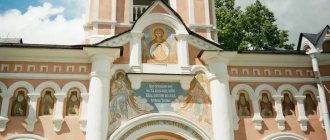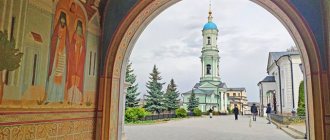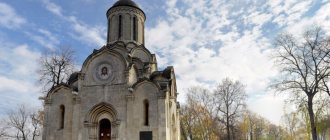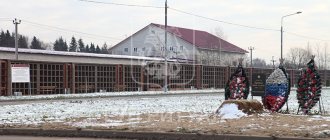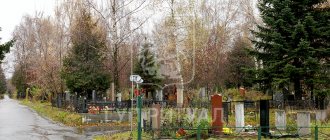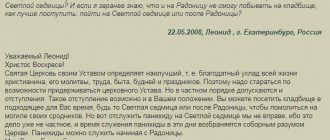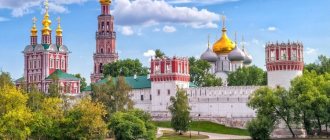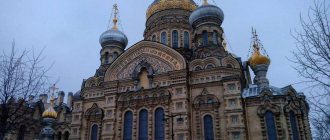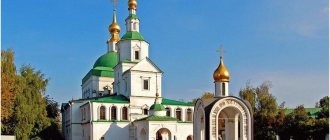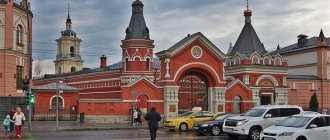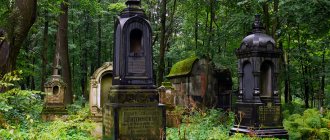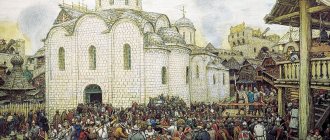Novodevichy Cemetery is one of the most famous Moscow graveyards. Included in the UNESCO list of “One Hundred Most Important Necropolises in the World” due to the presence of unique memorials and graves of many celebrities. According to rough estimates, over 26 thousand dead are buried here.
How to get to Novodevichy Cemetery:
By public transport:
From Art. metro station "Sportivnaya" take buses No. 64, No. 132, trolleybuses No. 5, No. 15 or walk across 10 Letiya Oktyabrya Street to the churchyard.
By your own transport:
From the Center, drive first along the Novodevichy embankment, then along the Krasnopresnenskaya embankment and turn towards the monastery.
From the Third Transport Ring, exit onto Luzhnetsky Proezd, where you drive around the necropolis to the main gate.
Coordinates:
55.724758, 37.554268
List of morgues in Moscow: basic information
Providing a free cemetery plot
List of active Moscow cemeteries
Celebrity graves
Novodevichy Cemetery is the resting place of many famous people. Among them:
- writers - M. Bulgakov, V. Mayakovsky, Agnia Barto, S. Marshak, V. Shukshin;
- musicians - D. Shostakovich, I. Dunaevsky, A. Vertinsky;
- artists - Y. Nikulin, L. Gurchenko, A. Raikin, A. Papanov, E. Leonov, I. Smoktunovsky, O. Yankovsky, O. Tabakov;
- politicians - B. Yeltsin, A. Mikoyan, V. Chernomyrdin;
- scientists and thinkers - V. Vinogradov, L. Vygotsky, I. Sechenov, V. Gilyarovsky;
- artists and sculptors - V. Mukhina, V. Serov;
- athletes - M. Botvinnik, F. Selin, N. Naydenov;
- military leaders and Heroes of the Soviet Union - A. Brusilov, M. Gromov, P. Koshevoy, A. Maresyev, P. Rybalko;
- close relatives of prominent personalities - R. Gorbachev (wife of M. Gorbachev), N. Alliluyeva (wife of I. Stalin), D. Ulyanov (brother of V. Lenin), etc.
Tombstone of M. Bulgakov, © Sergey Arkhipkin
Interesting sculptural monuments
On the territory of the country's most important churchyard there are many sculptural figures that attract the eye. Below is a selection of photos of the Novodevichy cemetery in Moscow with beautiful monuments to people who left their mark on history.
Yuri Vladimirovich Nikulin (actor, clown), in 2022 the country celebrated the 100th anniversary of his birth.
Lyudmila Markovna Gurchenko is a Soviet and Russian film actress, singer, director.
Vyacheslav Vasilievich Tikhonov is an actor who played roles in the most famous films of the USSR era.
Dmitry Aleksandrovich Hvorostovsky is an opera singer and baritone.
Eldar Aleksandrovich Ryazanov is a film director, playwright, screenwriter, and actor.
Looking at the monuments to these talented people, it’s hard to believe that they are no longer there. The sculptors depicted them so skillfully that the celebrities seem alive, and each of them seems to continue doing his favorite thing.
| Address: | 119048, Moscow, Luzhnetsky pr., 2 |
| Driving directions: | Art. metro station Sportivnaya avt. 64, 132, troll. 5, 15. Or when leaving the station. metro Sportivnaya turn right and walk along the street. 10th Anniversary of the October Revolution to the Novodevichy Convent, then turn left and walk along the monastery wall to the cemetery gate. |
| Cemetery phone number: | 8 |
Assistance in organizing funerals. Funeral service telephone 24 hours a day
Material from Wikipedia - the free encyclopedia
Novodevichy Cemetery is one of the most famous burial places for the dead in Moscow. It appeared in 1898 near the southern wall of the Novodevichy Convent. In Soviet times, it was turned into a kind of national pantheon - second in importance after the Kremlin wall. Located in the southwestern part of the Central Administrative District, in Khamovniki (Luzhnetsky proezd, 2)
The burials initially appeared in the 16th century on the territory of the nearby Novodevichy Convent. The latter was a burial place for nuns, nobility, and later also for people of other classes. By the beginning of the 20th century, there was practically no free space left on the territory of the monastery necropolis.
In 1898, two hectares of new land behind the southern wall of the monastery, previously occupied by the monastery gardens, were allocated to expand the cemetery. According to the design of the architect S.K. Rodionov, the steep slope behind the southern wall was leveled with bulk soil, a drainage system was installed, and the areas were laid out; The territory of the new cemetery was surrounded by brick walls and towers adjacent to the walls of the monastery. The architect I.P. Mashkov, who at that time was engaged in the restoration of the Smolensk Cathedral of the monastery, also took an active part in designing the territory of the new cemetery. By 1904, young trees were planted on the territory, which marked the system of longitudinal and transverse alleys of the cemetery. This part of the cemetery was officially opened in 1904, but burials began to take place even earlier. Currently, the fenced area behind the southern wall of the Monastery is usually called the “old Novodevichy cemetery”.
In 1949, the cemetery territory was expanded to the south (the so-called “new Novodevichye cemetery”), in 1950-1956 walls, gates and service premises were built around the new territory. At the end of the 1970s, the territory of the cemetery was expanded again - this is how the territory of the “newest Novodevichy Cemetery” was formed. Thus, currently the area of the Novodevichy cemetery includes the territory of eleven plots, the total area of which is more than 7.5 hectares. About 26,000 people are buried in the cemetery. History of burials Tombstones from graves destroyed during the Soviet “reconstruction” of the necropolis
Buried in the tomb, located in the basement of the monastery Smolensk Cathedral, are: the young daughter of Ivan the Terrible Anna, his daughter-in-law and daughter-in-law, the daughters of Tsar Alexei Mikhailovich, the sisters of Peter I, Princess Sophia (nun Susanna), Evdokia and Ekaterina Miloslavsky, the first wife of Peter I - Evdokia Lopukhina (monastically Elena), the families of princes Obolensky and boyar B. M. Khitrovo are buried here[3]. In the 19th century, the graves of merchants, writers, musicians, and scientists began to appear here.
In 1922, all the buildings of the monastery, valuables, and ancient monuments, including the necropolis, were taken under protection by the state, and the Novodevichy Convent became a museum. But in the 1930s, it was decided to reconstruct the territory of the monastery, turning it into a public garden with green lawns and asphalt alleys. In the necropolis of the Novodevichy Convent before its “reconstruction” there were over 2000 burials. Afterwards, only about a hundred tombstones survived (excluding burials in the basement of the Smolensk Cathedral). Thus, during the reconstruction of the monastery territory, the most valuable historical monument, the necropolis, was almost completely destroyed. The graves of many outstanding people of Russia turned out to be lost: contemporaries of A. S. Pushkin, writers D. N. Begichev, N. V. Putyata, N. S. Vsevolozhsky, chief prosecutor of the Holy Synod, historian, archaeologist, first explorer of the Kulikovo field S. D. Nechaev, S. A. Tuchkov, composer N. I. Pashkov, historian Sh. Spassky, hero of the Patriotic War of 1812 General P. A. Tuchkov and many others.
On the monastery territory, the burials of mainly Decembrists and heroes of the war of 1812, as well as famous professors and public figures, survived: Tombstones for Denis Davydov and his grandson Peter at the entrance to the Smolensk Cathedral
- poet D. V. Davydov (1784-1839),
- princes S. P. Trubetskoy (1790-1860), A. N. Muravyov (1792-1863),
- Lieutenant Colonel M. I. Muravyov-Apostol (1793-1886),
- Petrashevets A. N. Pleshcheev (1825-1893),
- writers I. I. Lazhechnikov (1790-1869) and A. F. Pisemsky (1821-1881),
- director of the orphanage N.V. Rukavishnikov (1845-1875),
- historian S. M. Solovyov (1820-1879), his sons Vladimir (1853-1900) and Vsevolod (1849-1903),
- historian and writer M. P. Pogodin (1800-1875),
- founder of the Historical Museum, Count A. S. Uvarov (1825-1884),
- General A. A. Brusilov (1853-1926),
- landowner, father of A. I. Herzen I. A. Yakovlev (1767-1846),
- Director of the Department of Spiritual Affairs of the Ministry of Spiritual Affairs and Public Education A. I. Turgenev (1784-1846),
- statesmen brothers N. A. (1818-1872) and D. A. Milyutin (1816-1912).
Near the apses of the Smolensk Cathedral the grave of the first local abbess Elena (died November 18, 1548) has been preserved. And one of the last to be buried on the territory of the Monastery was the first abbess, Mother Seraphima (Black) (1914-1999), after the resumption of the monastery’s activities in 1994 [4]. The ashes of the writer A.P. Chekhov (1860-1904) were originally buried on the territory of the monastery.
The territory of the Novodevichy Convent is included in the UNESCO World Heritage List. “Old” cemetery territory (sections 1–4)
Soon after the October Revolution, by decision of the All-Russian Central Executive Committee, the territory of the cemetery behind the southern monastery wall, which had previously been the burial place of ordinary Muscovites of Khamovnichesky and nearby areas, was given over for the burial of “persons of social standing”[5].
In the 1930s, during the period of destruction of many Moscow church and monastery cemeteries, the graves of a number of famous people were moved here [6]: the ashes of the writer N.V. Gogol were transferred from the cemetery of the Danilov Monastery, along with a monument and a fence (cross and gravestone calvary ), replaced in 1952 by a new monument with a bust of the writer by sculptor N.V. Tomsky, on the pedestal of which is inscribed: “N. To V. Gogol from the government of the Soviet Union.” On the occasion of the 200th anniversary of Gogol’s birth, the bust was dismantled and the calvary was restored on the grave.
The ashes of the poet D.V. Venevitinov and the writer S.T. Aksakov were transferred from the Simonov Monastery. From the destroyed Dorogomilovsky Jewish cemetery[7] - the ashes of the artist I. I. Levitan; from the cemetery of the Danilovsky Monastery the ashes of Sergei and Pavel Tretyakov. After the liquidation of the necropolis at the Church of the Nativity of the Blessed Virgin Mary in Vladykino, the remains of actress M. N. Ermolova were transferred to the Novodevichy cemetery[8].
On the old territory of the Novodevichy Cemetery there is a “cherry orchard” - a Moscow Art Theater site with the graves of Chekhov, Stanislavsky and the actors of his theater. Cherry trees bloom here in spring. Chekhov's tombstone was made in the neo-Russian style according to the design of L. M. Brailovsky and F. O. Shekhtel. The writer's body was transported to Moscow from the resort of Badenweiler in a refrigerator car designed for transporting oysters. A few days later he was buried on the territory of the monastery, next to the grave of Pavel Georgievich, his father. In Soviet times, the writer’s ashes were transferred to the territory of the Novodevichy cemetery.
On the old territory there is the grave of the great Russian bass F.I. Chaliapin, who died in Paris in 1938. Chaliapin's remains were transferred to Moscow and buried at the Novodevichy cemetery almost half a century after the death of the great singer, in 1984.
The numbering of plots on the “old” territory starts from the Central Alley, for plots 1 and 2 towards Luzhnetsky Proezd, for plots 3 and 4 towards the “newest” part. Section 1 consists of 47 rows (rows 1 to 40 are located perpendicular to the monastery wall, rows 41 to 47 are parallel to the wall of the monastery), section 2 consists of 41 rows, section 3 consists of 65 rows (rows 1 to 58 are located perpendicular to wall of the monastery, from 59 to 65 rows parallel to the wall of the monastery), section 4 consists of 61 rows.
Writers M. A. Bulgakov, V. A. Gilyarovsky, A. N. Tolstoy, V. V. Mayakovsky, Yu. K. Olesha, I. A. Ilf, E. G. Bagritsky, N. A are buried in the old territory Ostrovsky, S. Ya. Marshak, L. A. Kassil, V. M. Shukshin, directors V. I. Nemirovich-Danchenko, E. B. Vakhtangov, S. M. Eisenstein, Ya. A. Protazanov, V. I. Pudovkin, actors V. P. Maretskaya, M. M. Tarkhanov, L. P. Orlova, composers and musicians A. N. Scriabin, W. A. Mazetti, I. O. Dunaevsky, S. S. Prokofiev, D. D. Shostakovich, singers L. V. Sobinov, A. V. Nezhdanova, K. G. Derzhinskaya, sculptor V. I. Mukhina, scientists A. I. Abrikosov, S. I. Vavilov, V. I. Vernadsky , P. P. Kashchenko, O. E. Kutafin, V. P. Serbsky, I. M. Sechenov, aircraft designers D. P. Grigorovich, N. N. Polikarpov, architect A. V. Shchusev, surgeon N. N. Burdenko, political figures L. M. Kaganovich, A. M. Kollontai, A. I. Mikoyan, V. M. Molotov, A. A. Gromyko, V. S. Chernomyrdin, Stalin’s second wife N. S. Alliluyeva. New territory (sections 5-8) Cemetery wall-columbarium
The “new” area resulted from the expansion of the cemetery in the late 1940s and early 1950s. Within the walls of this part of the cemetery there is a columbarium for burying urns with the ashes of the deceased. Currently, the columbarium consists of seven thousand urns.
The first President of Russia, B.N. Yeltsin, is buried on the “new” territory. The President's grave is located in the Central Alley of the cemetery. On April 23, 2008, a monument to B. N. Yeltsin (sculptor G. Frangulyan) was unveiled at the burial site [9]. The symbolic tombstone is a half-mast Russian flag made of snow-white marble (white stripe of the banner), pink granite (red stripe) and ceramic mosaic (blue stripe). An Orthodox cross was placed nearby in the paving stones at the request of Boris Yeltsin’s widow[10].
The numbering of plots in the “new” territory for plots 5 (to the right of the entrance), 6 (to the left of the entrance) and 8 (to the left of plot 6, along the wall of Khamovnichesky Val) starts from the entrance to the cemetery. For section 7, located in the far part of the “new” territory, from the end of sections 5, 6 and 8. Section 7 can be divided into “left” (behind sections 6 and 8) and “right” (behind section 5) parts. 5th section consists of 44 rows (between 23 and 24 rows there is a Central Alley), 6th section consists of 40 rows (between 22 and 23 rows there is a Central Alley), 8th section consists of 46 rows and 7th section consists of 21 rows on the right side and 23 rows on the left side.
Writers A. T. Tvardovsky, I. G. Erenburg, N. A. Zabolotsky, Yu. S. Semenov, S. V. Mikhalkov, directors M. I. Romm, I. A. Pyryev, singers M. N. Bernes, L. A. Ruslanova, L. G. Zykina, A. N. Vertinsky, G. P. Vishnevskaya, E. V. Obraztsova, artist A. A. Deineka, aircraft designers A. N. Tupolev , S. V. Ilyushin, musicians S. T. Richter, M. L. Rostropovich, O. B. Feltsman, ballerinas G. S. Ulanova, E. S. Maksimova, actor and clown Yu. V. Nikulin, illusionists Emil Kio, his son Igor Kio, sculptors S. T. Konenkov, B. D. Korolev, M. G. Manizer, E. V. Vuchetich, V. E. Tsigal, cameraman V. I. Yusov, actor Yu. V. Yakovlev, political figures N. S. Khrushchev, R. M. Gorbachev, governor of the Krasnoyarsk Territory A. I. Lebed. “Newest” territory (areas 9-11)
The “newest” territory arose as a result of the expansion of the cemetery to the southwest in the late 1970s - early 1980s at the expense of the territory of the stone-cutting workshop. You can get to the new territory by moving along the Central Alley, leading from the entrance to the cemetery.
Many famous figures of Russian culture and art are buried in this part of the cemetery. Actors E. Leonov, E. Evstigneev, R. Bykov, A. Papanov, R. Plyatt, I. Ilyinsky, I. Smoktunovsky, O. Borisov, E. Matveev, N. Kryuchkov, K. Luchko, V. Tikhonov are buried here , M. Ulyanov, G. Zhzhenov, O. Yankovsky, L. Gurchenko, V. Sanaev; composers G. Sviridov, A. Schnittke, D. Kabalevsky, N. Bogoslovsky, M. Blanter, M. Fradkin, J. Frenkel; singers I. Kozlovsky, L. Utesov, K. Shulzhenko, I. Arkhipova, T. Shmyga; directors S. Bondarchuk, S. Gerasimov, B. Pokrovsky and others. Also buried here are: announcer Yu. Levitan, writers Yu. Nagibin, A. Ivanov, cosmonauts G. Titov and G. Beregovoy, pilot A. Maresyev, academician P. Kapitsa and professor S. Kapitsa, artist E. Kibrik and linguist A. Kibrik, founder of the “In the Animal World” program A. Zguridi, journalist A. Borovik, Olympic champion V. Brumel and many others. The further fate of the Novodevichy cemetery
After the death of Mstislav Rostropovich in 2007, the head of the presidential affairs, Vladimir Kozhin, stated that this grave would be the last in the cemetery, since there was no more burial space there[11]. Nevertheless, the burials of famous figures of science and culture continued after this statement. The resting place of the top officials of the state in the future should be the Federal War Memorial Cemetery in Mytishchi[12]. As an alternative to Novodevichy, the Troyekurovskoye cemetery is also considered as a national pantheon[13]. Tourism Propylaea at the entrance to the cemetery
The Novodevichy Cemetery is included in the list of many travel companies as a historical and cultural monument of the Russian capital. The cemetery is rich in tombstones made by famous sculptors: N. A. Andreev, M. K. Anikushin, E. V. Vuchetich, L. E. Kerbel, S. T. Konenkov, G. I. Motovilov, V. I. Mukhina , E.I. Neizvestny, N.V. Tomsky, I.D. Shadr, G.A. Shultz, N.B. Nikogosyan and others. Many graves and urns with ashes are cultural heritage monuments of regional and federal significance[14].
State Unitary Enterprise “Ritual” has created a tour bureau to conduct excursion programs to visit the Novodevichy and Vagankovsky cemeteries. Visits to the cemetery are from 9 a.m. to 5 p.m., admission is free and free.
The branches of Novodevichy are the Troyekurovskoye cemetery and the New territory of the Kuntsevskoye cemetery in the west of Moscow.
Territory
The Novodevichy cemetery was opened at the Novodevichy Convent for the burial of its servants. But years later, noble gentlemen began to be buried here. By the beginning of the 20th century. The churchyard area behind the southern wall of the monastery was expanded. Then expansions were made several more times: for example, in the 50s. XX century A New Territory was formed, and in the 70s. - New territory. Today the cemetery is divided into three parts:
- old cemetery - sections 1–4;
- new - sections 5–8;
- the newest is sections 9–11.
Today, the Novodevichy cemetery refers to new and newer plots, the old graveyard is practically forgotten. Dozens of tombstones that remain from him are placed haphazardly and often over the graves of others. On unkempt graves you can often see signs asking you to contact the cemetery administration. If appeals are not registered, such graves are soon liquidated.
Monument to E. Evstegneev, © acvazul-v2010
At the most important necropolis in Russia, two branches were recently opened: the Kuntsevo cemetery and the Federal War Memorial Cemetery in Mytishchi.
Within the walls of the Novodevichy Necropolis there is a columbarium containing more than 7 thousand urns. The columbarium is still in operation.
An alternative to the Novodevichy Cemetery as a national pantheon is the Troyekurovskoye Cemetery.
Graves of famous people
As has already been said, initially the monastery walls received the deceased from royal and noble families, and by the mid-19th century and until today, the Novodevichy cemetery became the final resting place of outstanding figures of Russia, regardless of their origin.
The architects of the obelisks sought to reflect the activities of the deceased in marble and stone, so many ensembles deserve special attention.
Monument at the grave of Raisa Gorbacheva
Thus, the monument to the first president of the Russian Federation, Boris Yeltsin, is a Russian tricolor fluttering from gusts of wind. To create it, red porphyry, blue mosaic and white marble were used. The burial place of the First Secretary of the CPSU Central Committee Nikita Khrushchev is marked by a tall obelisk, which consists of two parts - the politician’s face and the white and black chain framing it, symbolizing the bright future of communism and its black past of repression.
Monuments to scientists are extremely simple and minimalistic, for example, the grave of Vernadsky, an outstanding biologist, is marked by a tall stone made of white marble, at the very top of which is a bust of the academician. The grave of the theoretical physics genius Lev Landau is decorated with a dark metal column with his portrait at the top. The bas-relief plane is engraved on the stele of the famous aircraft designer Tupolev.
The necropolis also contains the graves of prominent writers, for example, Gogol rests here under a black granite mountain with a cross on top. And the simple and humane Anton Chekhov found his last refuge under a white stele in the New Russian style. The ashes of the futurist Mayakovsky were placed under a gray granite slab, and the favorite of the Soviet regime, Alexei Tolstoy, was buried under a medallion with his image and sketches of figures from his works. In addition to them, in the necropolis you can find the following graves:
- Ilya Ilf;
- Mikhail Bulgakova;
- Samuel Marshak;
- Vasily Shukshin;
- Valeria Bryusova.
Tomb of M. Bulgakov
A red granite slab with the Moscow Art Theater emblem marks the resting place of Stanislavsky, and for his follower Evgeniy Vakhtangov he created a sculpture of a woman in a mourning veil. A statue of Nikulin sits wearing his signature hat at his grave, and the figure of Lyudmila Gurchenko stands frozen on a bas-relief nearby. The sculpture of Chaliapin is located as impressively as the singer himself, who is buried here. The Novodevichy Cemetery also welcomed other artists under its shadow. Among them:
- Evgeny Evstigneev;
- Sergei Eisenstein;
- Oleg Yankovsky;
- Eldar Ryazanov;
- Lyudmila Zykina;
- Evgeny Leonov;
- Sergei Bondarchuk;
- Maxim Bernes;
- Sergei Prokofiev;
- Yuri Levitan.
Monument to Yuri Nikulin
For example, the graves of celebrities at the Novodevichy Cemetery are located throughout the territory; in some places there are separate alleys for them.
Advice! When visiting the necropolis, it is best to take a guided tour to visit all the significant places. In addition, the guide will be able not only to show the burial places of prominent people, but also tell interesting facts about them.
Vasily Shukshin is buried here despite the protests of his mother (she wanted to take her son to Siberia to his homeland), and Khrushchev is buried as a disgraced ruler.
Mass graves
Looking at the monuments of outstanding people, you can see the burials of the Novodevichy cemetery in Moscow, known as mass graves. Crew members who died in plane crashes in the following years are buried here: ANT-20 “Maxim Gorky” killed 49 people in 1935, Tu-144 - 6 people. in 1973, USSR B6 - 13 people. in 1938, Il-18 - 18 people. in 1964.
Old
In 1898, the tomb was expanded to the south of the monastery by two hectares, and brick walls were erected around this area. Under the leadership of architecture professor I.P. Mashkov, the plots were demarcated and trees were planted. The cemetery in Moscow was officially opened in 1904.
Which famous people are buried
Walking through the first four sections of the graveyard, you can see who is buried at the Novodevichy cemetery in Moscow, and remember what contribution these people made to the history of the country. Here you can see the monuments:
- Nadezhda Alliluyeva;
- Alexey Tolstoy;
- Bella Akhmadulina;
- Vladimir Mayakovsky;
- Evgenia Vakhtangova;
- Lyubov Orlova;
- Oleg Yankovsky;
- Samuel Marshak;
- Mikhail Bulgakov;
- Vasily Shukshin.
Story
The official opening of the Novodevichy cemetery took place in 1904, but the first burials appeared in the monastery graveyard back in 1525. The first universally revered burial in the cemetery was the grave of the hero of the Patriotic War, the poet Denis Davydov. By the middle of the 19th century. “persons of academic rank” who lived in Moscow were buried here. Moreover, a place in the churchyard was very expensive: from 300 rubles to a thousand.
It is interesting that initially, according to church tradition, the dead were buried not in the monastery, but in the parish church located on the territory of the cemetery. But after it was blown up by order of Napoleon, funeral services began to be held in the Novodevichy Convent. The first person to be buried in the monastery was Anton Chekhov. Over time, the graveyard became open for the burial of ordinary Muscovites.
Monument to N. Khrushchov, © acvazul-v2010
However, after the revolution of 1917, the cemetery began to be called “Novodevichy”, and only “persons of social status” began to be buried: writers, military personnel, political workers, artists. In the 30s, during the destruction of church and monastery cemeteries, the ashes of the writer N.V. Gogol, artist I. Levitan, and actress M. Ermolova were transferred to Novodevichye.
In the 70s visiting the Novodevichy cemetery was paid, since cases of vandalism at N. Khrushchov’s grave became more frequent. Today, visiting the necropolis is free.
In the 70–80s. of the last century, the pioneer squads of the 45th Moscow school kept order at the graves. Over time, the event turned into a local history elective called “Week of Good Deeds.”
In 2003, after the death of Mstislav Rostropovich, the country's government announced that burials would cease at the Novodevichy cemetery. And outstanding people will be buried at the Troekurovsky cemetery. However, nowadays plots can still be purchased if the deceased has significant services to the Fatherland or for a related burial. In some cases, the decision to provide a place at the Novodevichy cemetery is made at the state level.
Monuments to the heroes of the defense of Moscow, © Natalia Konnova
Newest
By the end of the 1970s, new burial plots were required, and this time the graveyard was expanded from the western part of the monastery, filling in the areas where the stone-masonry workshop and lake were located.
Which famous people are buried
Rolan Bykov, Leonid Persianinov, Lyudmila Gurchenko, Vyacheslav Tikhonov, Valery Shumakov, German Titov, Innokenty Smoktunovsky are just some of the celebrities buried at the Novodevichy Cemetery in Moscow; dozens of other famous people are also buried here.
What graves are worth visiting?
You can visit the graves of celebrities at the Novodevichy Moscow Cemetery only with a special pass or with a guided tour. Opening hours: 9:00 – 17:00. The walking tour, lasting 2 hours, is paid and takes place by appointment. Self-guided sightseeing is available for participants.
A map of the Novodevichy Cemetery indicating the graves will help you find the most notable monuments to the stars.
On the Central Alley at site No. 6 is the burial place of Boris Nikolayevich Yeltsin, the first president of Russia. In 2008, the opening of a monument in the form of the national flag took place. Work of sculptor G. Frangulyan.
Need expert advice?
Get expert advice online. Ask your question right now!
Ask a free question View all questions
Pavel Ivanovich Belyaev, pilot-cosmonaut, commander of the crew of the Voskhod-2 spacecraft, is buried in plot No. 3 in row 64. Above his grave at the Novodevichy Old Cemetery there is a bronze statue of the hero with a metal structure framing the figure.
In February 2013, a monument was unveiled at the burial site of People's Artist and operetta actress Tatyana Shmyga. Sculptors: Daria Uspenskaya, Vitaly Shanov. The composition represents the figure of the singer against the background of a bronze theater curtain and a backdrop with gold leaf.
New
In 1949, the burial area was again expanded to the south, and after that it doubled in size. The original burials became known as the "old" cemetery, and the added plot of land became known as the "new" cemetery. Over the next six years, the territory of the churchyard was improved, walls were erected around it, gates were installed, and service premises were built. A columbarium was placed within the walls, in which 7,000 urns with ashes were already buried by 2022.
Which famous people are buried
Walking through the “dead town”, in sections 5–8, you will see the following celebrity graves at the Novodevichy Cemetery in Moscow:
- Andrey Tupolev;
- Galina Volchek;
- Lyudmila Zykina;
- Galina Ulanova;
- Yury Nikulin;
- Nikita Khrushchev;
- Boris Yeltsin;
- Alexander Bakulev;
- Ilya Ehrenburg;
- Mstislav Rostropovich;
- Mikhail Romm;
- Raisa Gorbacheva.
